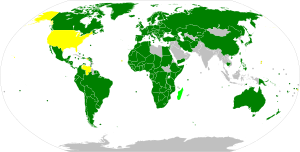Protocol Relating to the Status of Refugees
The Protocol Relating to the Status of Refugees is a key treaty in international refugee law. It entered into force on 4 October 1967, and 146 countries are parties.
 Parties to only the 1951 Convention
Parties to only the 1967 Protocol
Parties to both
Non-members | |
| Signed | 31 January 1967 |
|---|---|
| Location | New York |
| Effective | 4 October 1967 |
| Signatories | 19 |
| Parties | Convention: 145[1] Protocol: 146[1] |
| Depositary | Secretary-General of the United Nations |
| Languages | English and French (Chinese, Russian and Spanish) |
Where the 1951 United Nations Convention Relating to the Status of Refugees had restricted refugee status to those whose circumstances had come about "as a result of events occurring before 1 January 1951", as well as giving states party to the Convention the option of interpreting this as "events occurring in Europe" or "events occurring in Europe or elsewhere", the 1967 Protocol removed both the temporal and geographic restrictions. This was needed in the historical context of refugee flows resulting from decolonisation. Madagascar and Saint Kitts and Nevis are parties only to the Convention, while Cape Verde, the United States of America and Venezuela are parties only to the Protocol.
The Protocol gave those states which had previously ratified the 1951 Convention and chosen to use the definition restricted to Europe the option to retain that restriction. Only four states actually chose that restriction: the Republic of the Congo, Madagascar, Monaco, and Turkey. Congo and Monaco dropped the restriction upon ratifying the 1967 Protocol; Turkey retained it, and Madagascar has not ratified the Protocol.[2]
References
- "Chapter V – Refugees and Stateless Persons". United Nations Treaty Series. 22 July 2013. Archived from the original on 14 November 2012. Retrieved 22 July 2013.
- "States Parties to the 1951 Convention relating to the Status of Refugees and the 1967 Protocol" (PDF). April 2015. Retrieved 7 January 2019.
External links
- Introductory note by Guy S. Goodwin-Gill, procedural history note and audiovisual material on the Convention relating to the Status of Refugees and the Protocol relating to the Status of Refugees in the Historic Archives of the United Nations Audiovisual Library of International Law
- Lectures by Guy S. Goodwin-Gill entitled International Migration Law – A General Introduction and Forced Migration – The Evolution of International Refugee Law and Organization in the Lecture Series of the United Nations Audiovisual Library of International Law
- Ratifications
- Protocol Relating to the Status of Refugees of 31 January 1967 - English text